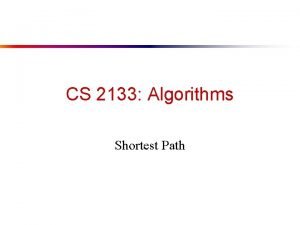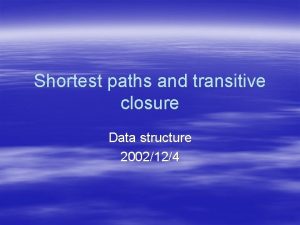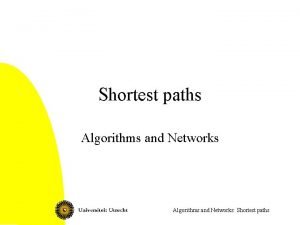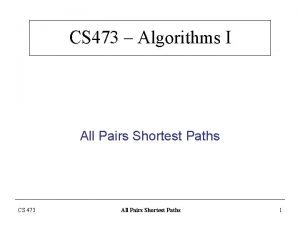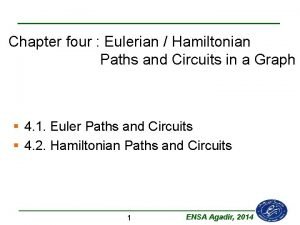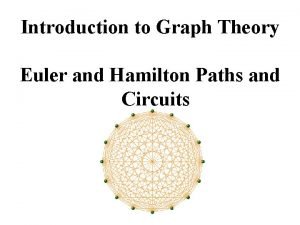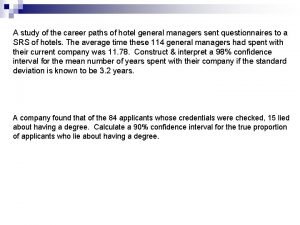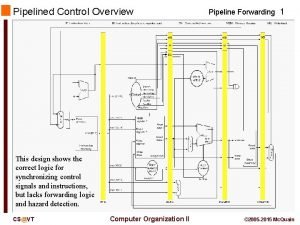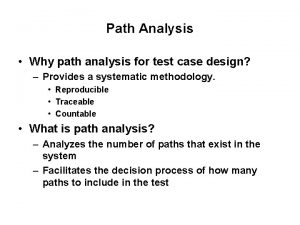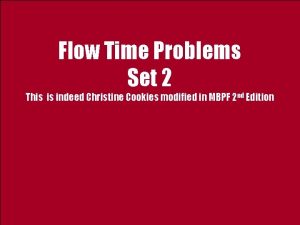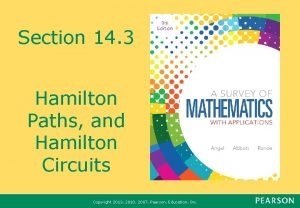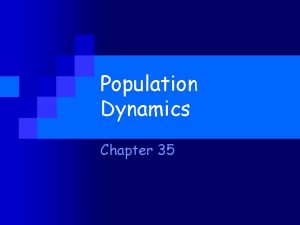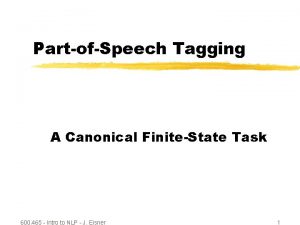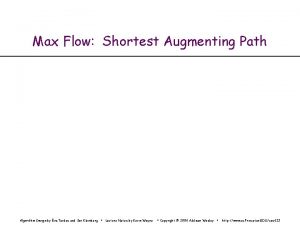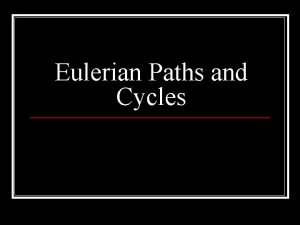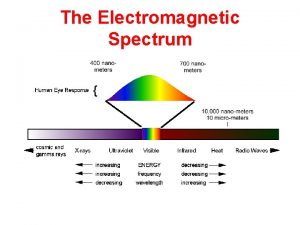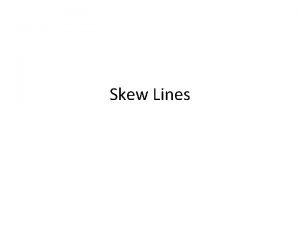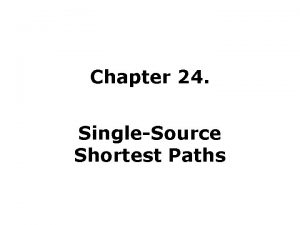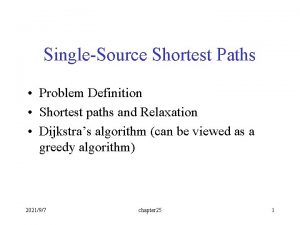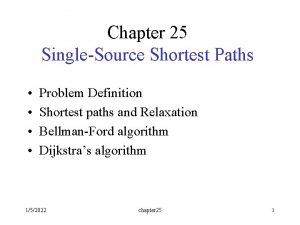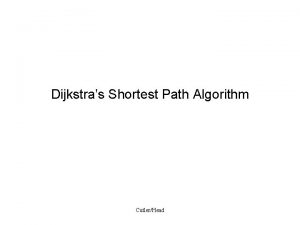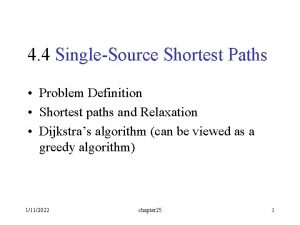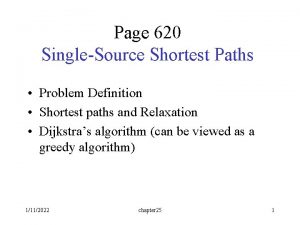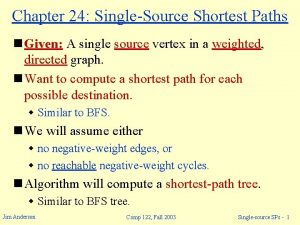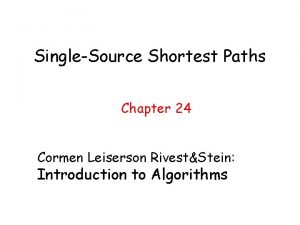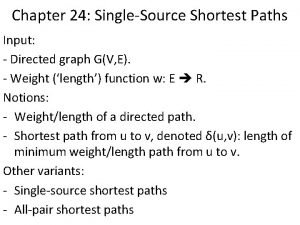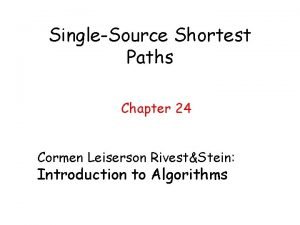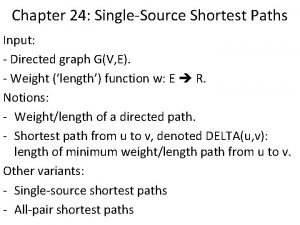Chapter 24 SingleSource Shortest Paths n Given A




![Relaxation Algorithms keep track of d[v], [v]. Initialized as follows: Initialize(G, s) for each Relaxation Algorithms keep track of d[v], [v]. Initialized as follows: Initialize(G, s) for each](https://slidetodoc.com/presentation_image_h2/18f7026df404cb9bd4d30e42af957358/image-5.jpg)
![Properties of Relaxation n d[v], if not , is the length of some path Properties of Relaxation n d[v], if not , is the length of some path](https://slidetodoc.com/presentation_image_h2/18f7026df404cb9bd4d30e42af957358/image-6.jpg)
![Properties of Relaxation Consider any algorithm in which d[v], and [v] are first initialized Properties of Relaxation Consider any algorithm in which d[v], and [v] are first initialized](https://slidetodoc.com/presentation_image_h2/18f7026df404cb9bd4d30e42af957358/image-7.jpg)





![Proof of (1) (Continued) Before call to Relax(vk-1, vk, w): [vi] = vi-1 for Proof of (1) (Continued) Before call to Relax(vk-1, vk, w): [vi] = vi-1 for](https://slidetodoc.com/presentation_image_h2/18f7026df404cb9bd4d30e42af957358/image-13.jpg)
![Comment on Proof n d[vi] d[vi-1] + w(vi-1, vi) for i = 1, …, Comment on Proof n d[vi] d[vi-1] + w(vi-1, vi) for i = 1, …,](https://slidetodoc.com/presentation_image_h2/18f7026df404cb9bd4d30e42af957358/image-14.jpg)












![Lemma 24. 2: Assuming no negative-weight cycles reachable from s, d[v] = (s, v) Lemma 24. 2: Assuming no negative-weight cycles reachable from s, d[v] = (s, v)](https://slidetodoc.com/presentation_image_h2/18f7026df404cb9bd4d30e42af957358/image-27.jpg)

















![Correctness Theorem 24. 6: Upon termination, d[u] = δ(s, u) for all u in Correctness Theorem 24. 6: Upon termination, d[u] = δ(s, u) for all u in](https://slidetodoc.com/presentation_image_h2/18f7026df404cb9bd4d30e42af957358/image-45.jpg)

![Proof (Continued) Claim: d[y] = (s, y) when u is inserted into S. We Proof (Continued) Claim: d[y] = (s, y) when u is inserted into S. We](https://slidetodoc.com/presentation_image_h2/18f7026df404cb9bd4d30e42af957358/image-47.jpg)

- Slides: 48

Chapter 24: Single-Source Shortest Paths n Given: A single source vertex in a weighted, directed graph. n Want to compute a shortest path for each possible destination. w Similar to BFS. n We will assume either w no negative-weight edges, or w no reachable negative-weight cycles. n Algorithm will compute a shortest-path tree. w Similar to BFS tree. Jim Anderson Comp 122, Fall 2003 Single-source SPs - 1

Outline n General Lemmas and Theorems. w CLRS now does this last. We’ll still do it first. n Bellman-Ford algorithm. n DAG algorithm. n Dijkstra’s algorithm. n We will skip Section 24. 4. Jim Anderson Comp 122, Fall 2003 Single-source SPs - 2

General Results (Relaxation) Lemma 24. 1: Let p = ‹v 1, v 2, …, vk› be a SP from v 1 to vk. Then, pij = ‹vi, vi+1, …, vj› is a SP from vi to vj, where 1 i j k. So, we have the optimal-substructure property. Bellman-Ford’s algorithm uses dynamic programming. Dijkstra’s algorithm uses the greedy approach. Let δ(u, v) = weight of SP from u to v. Corollary: Let p = SP from s to v, where p = s δ(s, v) = δ(s, u) + w(u, v). u v. Then, Lemma 24. 10: Let s V. For all edges (u, v) E, we have δ(s, v) δ(s, u) + w(u, v). Jim Anderson Comp 122, Fall 2003 Single-source SPs - 3

n Lemma 24. 1 holds because one edge gives the shortest path, so the other edges must give sums that are at least as large. Jim Anderson Comp 122, Fall 2003 Single-source SPs - 4
![Relaxation Algorithms keep track of dv v Initialized as follows InitializeG s for each Relaxation Algorithms keep track of d[v], [v]. Initialized as follows: Initialize(G, s) for each](https://slidetodoc.com/presentation_image_h2/18f7026df404cb9bd4d30e42af957358/image-5.jpg)
Relaxation Algorithms keep track of d[v], [v]. Initialized as follows: Initialize(G, s) for each v V[G] do d[v] : = ; [v] : = NIL od; d[s] : = 0 These values are changed when an edge (u, v) is relaxed: Relax(u, v, w) if d[v] > d[u] + w(u, v) then d[v] : = d[u] + w(u, v); [v] : = u fi Jim Anderson Comp 122, Fall 2003 Single-source SPs - 5
![Properties of Relaxation n dv if not is the length of some path Properties of Relaxation n d[v], if not , is the length of some path](https://slidetodoc.com/presentation_image_h2/18f7026df404cb9bd4d30e42af957358/image-6.jpg)
Properties of Relaxation n d[v], if not , is the length of some path from s to v. n d[v] either stays the same or decreases with time n Therefore, if d[v] = (s, v) at any time, this holds thereafter n Note that d[v] (s, v) always n After i iterations of relaxing on all (u, v), if the shortest path to v has i edges, then d[v] = (s, v). Jim Anderson Comp 122, Fall 2003 Single-source SPs - 6
![Properties of Relaxation Consider any algorithm in which dv and v are first initialized Properties of Relaxation Consider any algorithm in which d[v], and [v] are first initialized](https://slidetodoc.com/presentation_image_h2/18f7026df404cb9bd4d30e42af957358/image-7.jpg)
Properties of Relaxation Consider any algorithm in which d[v], and [v] are first initialized by calling Initialize(G, s) [s is the source], and are only changed by calling Relax. We have: Lemma 24. 11: ( v: : d[v] (s, v)) is an invariant. Implies d[v] doesn’t change once d[v] = (s, v). Proof: Initialize(G, s) establishes invariant. If call to Relax(u, v, w) changes d[v], then it establishes: d[v] = d[u] + w(u, v) (s, u) + w(u, v) , invariant holds before call. (s, v) , by Lemma 24. 10. Corollary 24. 12: If there is no path from s to v, then d[v] = δ(s, v) = is an invariant. Jim Anderson Comp 122, Fall 2003 Single-source SPs - 7

n For lemma 24. 11, note that initialization makes the invariant true at the beginning. Jim Anderson Comp 122, Fall 2003 Single-source SPs - 8

More Properties Lemma 24. 13: Immediately after relaxing edge (u, v) by calling Relax(u, v, w), we have d[v] d[u] + w(u, v). Lemma 24. 14: Let p = SP from s to v, where p = s u v. If d[u] = δ(s, u) holds at any time prior to calling Relax(u, v, w), then d[v] = δ(s, v) holds at all times after the call. Proof: After the call we have: d[v] d[u] + w(u, v) = (s, u) + w(u, v) = (s, v) , by Lemma 24. 13. , d[u] = (s, u) holds. , by corollary to Lemma 24. 1. By Lemma 24. 11, d[v] δ(s, v), so d[v] = δ(s, v). Jim Anderson Comp 122, Fall 2003 Single-source SPs - 9

n Lemma 24. 13 follows simply from the structure of Relax. n Lemma 24. 14 shows that the shortest path will be found one vertex at a time, if not faster. Thus after a number of iterations of Relax equal to V(G) - 1, all shortest paths will be found. Jim Anderson Comp 122, Fall 2003 Single-source SPs - 10

n Bellman-Ford returns a compact representation of the set of shortest paths from s to all other vertices in the graph reachable from s. This is contained in the predecessor subgraph. Jim Anderson Comp 122, Fall 2003 Single-source SPs - 11

Predecessor Subgraph Lemma 24. 16: Assume given graph G has no negative-weight cycles reachable from s. Let G = predecessor subgraph. G is always a tree with root s (i. e. , this property is an invariant). Proof: Two proof obligations: (1) G is acyclic. (2) There exists a unique path from source s to each vertex in V. Proof of (1): Suppose there exists a cycle c = ‹v 0, v 1, …, vk›, where v 0 = vk. We have [vi] = vi-1 for i = 1, 2, …, k. Assume relaxation of (vk-1, vk) created the cycle. We show cycle has a negative weight. Note: Cycle must be reachable from s. (Why? ) Jim Anderson Comp 122, Fall 2003 Single-source SPs - 12
![Proof of 1 Continued Before call to Relaxvk1 vk w vi vi1 for Proof of (1) (Continued) Before call to Relax(vk-1, vk, w): [vi] = vi-1 for](https://slidetodoc.com/presentation_image_h2/18f7026df404cb9bd4d30e42af957358/image-13.jpg)
Proof of (1) (Continued) Before call to Relax(vk-1, vk, w): [vi] = vi-1 for i = 1, …, k– 1. Implies d[vi] was last updated by “d[vi] : = d[vi-1] + w(vi-1, vi)” for i = 1, …, k– 1. [Because Relax updates . ] Implies d[vi] d[vi-1] + w(vi-1, vi) for i = 1, …, k– 1. [Lemma 24. 13] Because [vk] is changed by call, d[vk] > d[vk-1] + w(vk-1, vk). Thus, Jim Anderson Comp 122, Fall 2003 Single-source SPs - 13
![Comment on Proof n dvi dvi1 wvi1 vi for i 1 Comment on Proof n d[vi] d[vi-1] + w(vi-1, vi) for i = 1, …,](https://slidetodoc.com/presentation_image_h2/18f7026df404cb9bd4d30e42af957358/image-14.jpg)
Comment on Proof n d[vi] d[vi-1] + w(vi-1, vi) for i = 1, …, k– 1 because when Relax(vi-1 , vi , w) was called, there was an equality, and d[vi-1] may have gotten smaller by further calls to Relax. n d[vk] > d[vk-1] + w(vk-1, vk) before the last call to Relax because that last call changed d[vk]. Jim Anderson Comp 122, Fall 2003 Single-source SPs - 14

Proof of (2): ( v: v V : : ( path from s to v)) is an invariant. So, for any v in V , at least 1 path from s to v. Show 1 path. Assume 2 paths. x s u z v y impossible! Jim Anderson Comp 122, Fall 2003 Single-source SPs - 15

Lemma 24. 17: Same conditions as before. Call Initialize & repeatedly call Relax until d[v] = δ(s, v) for all v in V. Then, G is a shortest-path tree rooted at s. Proof: Key Proof Obligation: For all v in V , the unique simple path p from s to v in G (path exists by Lemma 24. 16) is a shortest path from s to v in G. Let p = ‹v 0, v 1, …, vk›, where v 0 = s and vk = v. We have d[vi] = δ(s, vi) d[vi] d[vi-1] + w(vi-1, vi) (reasoning as before) Implies w(vi-1, vi) δ(s, vi) – δ(s, vi-1). Jim Anderson Comp 122, Fall 2003 Single-source SPs - 16

Proof (Continued) So, equality holds and p is a shortest path. Jim Anderson Comp 122, Fall 2003 Single-source SPs - 17

n And note that this shortest path tree will be found after V(G) - 1 iterations of Relax. Jim Anderson Comp 122, Fall 2003 Single-source SPs - 18

Bellman-Ford Algorithm Can have negative-weight edges. Will “detect” reachable negative-weight cycles. Initialize(G, s); for i : = 1 to |V[G]| – 1 do for each (u, v) in E[G] do Relax(u, v, w) Time od Complexity od; is O(VE). for each (u, v) in E[G] do if d[v] > d[u] + w(u, v) then return false fi od; return true Jim Anderson Comp 122, Fall 2003 Single-source SPs - 19

n So if Bellman-Ford has not converged after V(G) - 1 iterations, then there cannot be a shortest path tree, so there must be a negative weight cycle. Jim Anderson Comp 122, Fall 2003 Single-source SPs - 20

Example u v 5 – 2 6 – 3 8 z 0 – 4 7 2 7 x Jim Anderson 9 Comp 122, Fall 2003 y Single-source SPs - 21

Example u 6 v 5 – 2 6 – 3 8 z 0 – 4 7 2 7 7 x Jim Anderson 9 Comp 122, Fall 2003 y Single-source SPs - 22

Example u 6 v 5 – 2 6 – 3 8 z 0 7 – 4 2 7 7 x Jim Anderson 4 9 Comp 122, Fall 2003 2 y Single-source SPs - 23

Example u 2 v 5 – 2 6 – 3 8 z 0 7 – 4 2 7 7 x Jim Anderson 4 9 Comp 122, Fall 2003 2 y Single-source SPs - 24

Example u 2 v 5 – 2 6 – 3 8 z 0 – 4 7 2 7 7 x Jim Anderson 4 9 Comp 122, Fall 2003 -2 y Single-source SPs - 25

Another Look Note: This is essentially dynamic programming. Let d(i, j) = cost of the shortest path from s to i that is at most j hops. d(i, j) = 0 min({d(k, j– 1) + w(k, i): i Adj(k)} {d(i, j– 1)}) j 0 1 2 3 4 Jim Anderson i z 1 0 0 0 u 2 6 6 2 2 v 3 4 4 4 if i = s j = 0 if i s j = 0 if j > 0 x y 4 5 7 7 2 7 – 2 Comp 122, Fall 2003 Single-source SPs - 26
![Lemma 24 2 Assuming no negativeweight cycles reachable from s dv s v Lemma 24. 2: Assuming no negative-weight cycles reachable from s, d[v] = (s, v)](https://slidetodoc.com/presentation_image_h2/18f7026df404cb9bd4d30e42af957358/image-27.jpg)
Lemma 24. 2: Assuming no negative-weight cycles reachable from s, d[v] = (s, v) holds upon termination for all vertices v reachable from s. Proof: Consider a SP p, where p = ‹v 0, v 1, …, vk›, where v 0 = s and vk = v. Assume k |V| – 1, otherwise p has a cycle. Claim: d[vi] = (s, vi) holds after the ith pass over edges. Proof follows by induction on i. By Lemma 24. 11, once d[vi] = (s, vi) holds, it continues to hold. Jim Anderson Comp 122, Fall 2003 Single-source SPs - 27

Correctness Claim: Algorithm returns the correct value. (Part of Theorem 24. 4. Other parts of theorem follow easily from earlier results. ) Case 1: There is no reachable negative-weight cycle. Upon termination, we have for all (u, v): d[v] = (s, v) , by lemma 24. 2 (last slide) if v is reachable; d[v] = (s, v) = otherwise. (s, u) + w(u, v) , by Lemma 24. 10. = d[u] + w(u, v) So, algorithm returns true. Jim Anderson Comp 122, Fall 2003 Single-source SPs - 28

Case 2: There exists a reachable negative-weight cycle c = ‹v 0, v 1, …, vk›, where v 0 = vk. We have i = 1, …, k w(vi-1, vi) < 0. (*) Suppose algorithm returns true. Then, d[vi] d[vi-1] + w(vi-1, vi) for i = 1, …, k. (because Relax didn’t change any d[vi] ). Thus, i = 1, …, k d[vi] But, i = 1, …, k d[vi] = i = 1, …, k d[vi-1] + i = 1, …, k w(vi-1, vi) i = 1, …, k d[vi-1]. Can show no d[vi] is infinite. Hence, 0 i = 1, …, k w(vi-1, vi). Contradicts (*). Thus, algorithm returns false. Jim Anderson Comp 122, Fall 2003 Single-source SPs - 29

Shortest Paths in DAGs Topologically sort vertices in G; Initialize(G, s); for each u in V[G] (in order) do for each v in Adj[u] do Relax(u, v, w) od od Jim Anderson Comp 122, Fall 2003 Single-source SPs - 30

Example 6 r 5 s 0 2 t 1 u 7 – 1 v – 2 w 4 3 Jim Anderson 2 Comp 122, Fall 2003 Single-source SPs - 31

Example 6 r 5 s 0 2 t 1 u 7 – 1 v – 2 w 4 3 Jim Anderson 2 Comp 122, Fall 2003 Single-source SPs - 32

Example 6 r 5 s 0 2 t 2 1 u 7 6 – 1 v – 2 w 4 3 Jim Anderson 2 Comp 122, Fall 2003 Single-source SPs - 33

Example 6 r 5 s 0 2 t 2 1 u 7 6 – 1 v 6 – 2 w 4 4 3 Jim Anderson 2 Comp 122, Fall 2003 Single-source SPs - 34

Example 6 r 5 s 0 2 t 2 1 u 7 6 – 1 v 5 – 2 w 4 4 3 Jim Anderson 2 Comp 122, Fall 2003 Single-source SPs - 35

Example 6 r 5 s 0 2 t 2 1 u 7 6 – 1 v 5 – 2 w 3 4 3 Jim Anderson 2 Comp 122, Fall 2003 Single-source SPs - 36

Example 6 r 5 s 0 2 t 2 1 u 7 6 – 1 v 5 – 2 w 3 4 3 Jim Anderson 2 Comp 122, Fall 2003 Single-source SPs - 37

Dijkstra’s Algorithm Assumes no negative-weight edges. Maintains a set S of vertices whose SP from s has been determined. Repeatedly selects u in V–S with minimum SP estimate (greedy choice). Store V–S in priority queue Q. Initialize(G, s); S : = ; Q : = V[G]; while Q do u : = Extract-Min(Q); S : = S {u}; for each v Adj[u] do Relax(u, v, w) od od Jim Anderson Comp 122, Fall 2003 Single-source SPs - 38

Example u 1 10 s 2 0 3 9 4 6 7 5 x Jim Anderson v 2 Comp 122, Fall 2003 y Single-source SPs - 39

Example u 1 10 10 s 2 0 3 9 4 6 7 5 5 x Jim Anderson v 2 Comp 122, Fall 2003 y Single-source SPs - 40

Example u 1 8 10 s 2 0 3 14 9 4 6 7 5 5 x Jim Anderson v 2 Comp 122, Fall 2003 7 y Single-source SPs - 41

Example u 1 8 10 s 2 0 3 13 9 4 6 7 5 5 x Jim Anderson v 2 Comp 122, Fall 2003 7 y Single-source SPs - 42

Example u 1 8 10 s 2 0 3 9 9 4 6 7 5 5 x Jim Anderson v 2 Comp 122, Fall 2003 7 y Single-source SPs - 43

Example u 1 8 10 s 2 0 3 9 9 4 6 7 5 5 x Jim Anderson v 2 Comp 122, Fall 2003 7 y Single-source SPs - 44
![Correctness Theorem 24 6 Upon termination du δs u for all u in Correctness Theorem 24. 6: Upon termination, d[u] = δ(s, u) for all u in](https://slidetodoc.com/presentation_image_h2/18f7026df404cb9bd4d30e42af957358/image-45.jpg)
Correctness Theorem 24. 6: Upon termination, d[u] = δ(s, u) for all u in V (assuming non-negative weights). Proof: By Lemma 24. 11, once d[u] = δ(s, u) holds, it continues to hold. We prove: For each u in V, d[u] = (s, u) when u is inserted in S. Suppose not. Let u be the first vertex such that d[u] (s, u) when inserted in S. Note that d[s] = (s, s) = 0 when s is inserted, so u s. S just before u is inserted (in fact, s S). Jim Anderson Comp 122, Fall 2003 Single-source SPs - 45

Proof (Continued) Note that there exists a path from s to u, for otherwise d[u] = (s, u) = by Corollary 24. 12. there exists a SP from s to u. SP looks like this: p 2 u s p 1 x y S Jim Anderson Comp 122, Fall 2003 Single-source SPs - 46
![Proof Continued Claim dy s y when u is inserted into S We Proof (Continued) Claim: d[y] = (s, y) when u is inserted into S. We](https://slidetodoc.com/presentation_image_h2/18f7026df404cb9bd4d30e42af957358/image-47.jpg)
Proof (Continued) Claim: d[y] = (s, y) when u is inserted into S. We had d[x] = (s, x) when x was inserted into S. Edge (x, y) was relaxed at that time. By Lemma 24. 14, this implies the claim. Now, we have: d[y] = (s, y) , by Claim. (s, u) , nonnegative edge weights. d[u] , by Lemma 24. 11. Because u was added to S before y, d[u] d[y]. Thus, d[y] = (s, y) = (s, u) = d[u]. Contradiction. Jim Anderson Comp 122, Fall 2003 Single-source SPs - 47

Complexity Running time is O(V 2) using linear array for priority queue. O((V + E) lg V) using binary heap. O(V lg V + E) using Fibonacci heap. (See book. ) Jim Anderson Comp 122, Fall 2003 Single-source SPs - 48
 Dijkstra algorithm
Dijkstra algorithm Undirected
Undirected Single-source shortest paths
Single-source shortest paths Shortest paths and transitive closure in data structure
Shortest paths and transitive closure in data structure Floyd-warshall演算法
Floyd-warshall演算法 Shortest path problem linear programming
Shortest path problem linear programming Difference constraints and shortest paths
Difference constraints and shortest paths Sssp
Sssp Chartwell staffing solutions jobs
Chartwell staffing solutions jobs Dual career path
Dual career path Sherry hamby
Sherry hamby Horticulture career paths
Horticulture career paths Many paths lead to the same destination
Many paths lead to the same destination Euler path vs circuit
Euler path vs circuit Linearly independent paths
Linearly independent paths 6 paths framework
6 paths framework Special challenges in career management
Special challenges in career management Wave winding parallel paths
Wave winding parallel paths Euler
Euler Teach me your ways oh lord
Teach me your ways oh lord Dd path testing
Dd path testing Jeremiah 6 16
Jeremiah 6 16 Paths, trees, and flowers
Paths, trees, and flowers Euler and hamilton paths and circuits
Euler and hamilton paths and circuits A study of the career paths of hotel general managers
A study of the career paths of hotel general managers Yes there are two paths
Yes there are two paths Paths to god
Paths to god Jeremiah ancient paths
Jeremiah ancient paths Forwarding paths pipeline
Forwarding paths pipeline Linearly independent paths
Linearly independent paths Linearly independent paths
Linearly independent paths Theoretical flow time formula
Theoretical flow time formula Eightfold path poster
Eightfold path poster Theoretical flow time for alternative paths
Theoretical flow time for alternative paths Six paths framework
Six paths framework Load paths
Load paths Parabolic paths
Parabolic paths Sec 7.4 hamilton circuits and paths
Sec 7.4 hamilton circuits and paths Parasitism
Parasitism Prime factorization of 630
Prime factorization of 630 Length of path
Length of path Eulerian paths
Eulerian paths Migratory paths of early humans
Migratory paths of early humans Description
Description Which color has the shortest wavelength
Which color has the shortest wavelength Shortest path to get food
Shortest path to get food Longest wavelength to shortest
Longest wavelength to shortest Shortest distance between two skew lines
Shortest distance between two skew lines Floyd warshall parallel
Floyd warshall parallel


